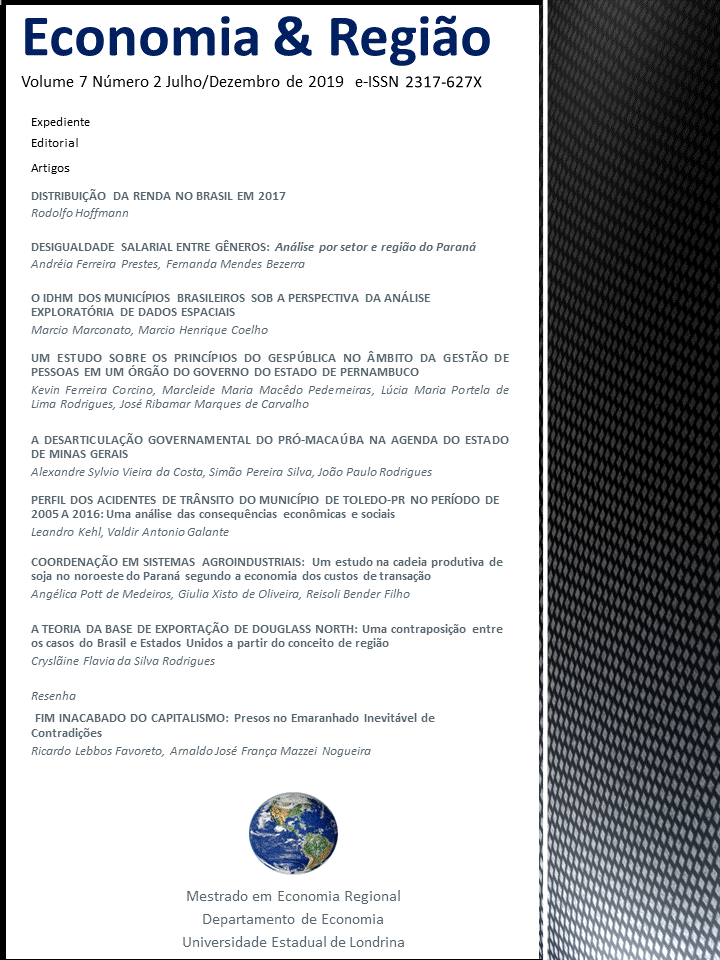The IDHM of the brazilian municipalities under the perspective of the exploratory analysis of space data
DOI:
https://doi.org/10.5433/2317-627X.2019v7n2p49Keywords:
Public sector, AEDE, Clusters, Longevity, Education, IncomeAbstract
The objective of the present study was to verify the changes in the spatial distribution of the Municipal Human Development Index (IDHM) among Brazilian municipalities in the years of 1991 and 2010. The indicator, associated with three-dimensional observation, longevity, education and income, allows the visualization of how much the progress of a municipality is fair. The research method consisted of exploratory spatial data analysis (AEDE), using transition matrices applied and presented by Rey (2001). The results showed the existence of positive spatial autocorrelation in the two analyzed years. The analysis of the spatial distribution revealed that 90.7% of the municipalities that were in the group of low development in 1991, remained in the same situation in 2010. The indicator of education was the one that evolved more in percentage terms, although in the absolute condition it has below the indicators of longevity and income. Taking into account the size of the municipalities, the units with low population, located mainly in the North and Northeast, and presented IDHM below the national average. In relation to the Brazilian capitals, the good levels of socioeconomic development were observed in the South, Southeast and Central-West regions.References
ANSELIN, L. Local indicators of spatial association (LISA). Geographical Analysis, v. 27, n. 2, p. 93-115, 1995.
ANSELIN, L. Spatial econometrics: methods and models. Boston: Kluwer Academic, 1988.
ANSELIN, L. Interactive techniques and exploratory spatial data analysis. Geographical Information Systems: principles, techniques, management and applications, v. 1, p. 251-264, 1999.
BASTOS, C. P.; BRITTO, G. Introdução. In: AGARWALA, A. N.; SINGH, S. P. (Org). A economia do subdesenvolvimento. Rio de Janeiro: Contraponto: Centro Internacional Celso Furtado, 2010.
BATELLA, W. B.; DINIZ, A. M. A. Desenvolvimento humano e hierarquia urbana: uma análise do IDHM entre as cidades mineiras. Revista de Biologia e Ciências da Terra, v. 6, p. 367-374, 2006.
CAVALCANTE, A. A.; SILVA, R. G.; ALMEIDA, E. S.; CAVALCANTI, F. C. S. Análise da convergência do Índice de Desenvolvimento Humano na Amazônia Sul-Ocidental no período de 1991 a 2000. Revista Brasileira de Gestão e Desenvolvimento Regional, v. 6, p. 214-238, 2010.
COSTA. A. M. B.; SILVA, F. M.; GOMES, C.; CUELLAR, M. Z.; ALMEIDA, S. A. S.; AMORIM, R. F.; CARVALHO, M. J. M. Comportamento espacial do Índice de Desenvolvimento Humano no Rio Grande do Norte com uso do programa Terra View (desenvolvido pelo INPE). In: SIMPÓSIO BRASILEIRO DE SENSORIAMENTO REMOTO, 13., 2007, Florianópolis. Anais... Florianópolis: SBSR, 2007.
FURTADO, C. O mito do desenvolvimento econômico. 3 ed. Rio de Janeiro: Paz e Terra, 1974.
JORGE, M. A.; FREI, F.; SALES, J. M. S.; LIMA, B. M. Cálculo e implementação do índice de desenvolvimento da gestão municipal (IDGM) do município de Itabaiana/SE. Planejamento e Políticas Públicas, Brasília, v. 34, p. 9-34, 2010.
LEGALLO, J.; ERTUR, C. Exploratory spatial data analysis of the distribution of regional per capita GDP in Europe, 1980-1995. Papers of Regional Science, v. 82, n. 2, p. 175-201, 2003.
LINS, J. G. M. G.; LOURES, A. R.; FILHO, S. C. L.; SILVA, M. V. B. Análise espacial da evolução do índice de desenvolvimento humano nos municípios da região Nordeste. Revista Economia e Desenvolvimento, v. 14, n. 1, 2015.
LORENA, R. B.; BERGAMASCHI, R. B.; LEITE, G. R. Análise exploratória espacial do Índice de Desenvolvimento Humano municipal do estado do Espírito Santo. In: SIMPÓSIO BRASILEIRO DE SENSORIAMENTO REMOTO, 15., 2011, Curitiba. Anais... São José dos Campos: INPE, p. 4776-4782, 2011.
LOVE, J. A construção do terceiro mundo: teorias do subdesenvolvimento na Romênia e no Brasil. Rio de Janeiro: Paz e Terra,1998.
MYRDAL, Gunnar. Teoria econômica e regiões subdesenvolvidas. Rio de Janeiro: Saga, 1965.
PIRAS, G.; LOZANO-GRACIA, N. Spatial J-test: some Monte Carlo evidence. Statisticsand Computing, v. 22, p. 169–183, 2012.
PNUD - PROGRAMA DAS NAÇÕES UNIDAS PARA O DESENVOLVIMENTO. Índice de desenvolvimento humano. Disponível em: www.atlasbrasil.org.br/2013/consulta. Acesso em: 20 jul. 2015.
ORD, J.; GETIS, A. Local spatial autocorrelation statistics: distributional issues and an application. Geographical Analysis, v. 27, n. 1, p. 296-305, 1995.
SANTOS, H. G.; SILVA, J. A. M.; PORTUGAL, J. L. Análise espacial do índice de desenvolvimento humano municipal na região semiárida brasileira. Revista Brasileira de Geomática, v.3, n. 2, p. 70-76, 2015.
SCHUMPETER, J. A. Teoria do desenvolvimento econômico: uma investigação sobre lucros, capital, crédito, juro e o ciclo econômico. São Paulo: Abril Cultural, 1982.E d. orig. de 1964.
SEN, A. Desenvolvimento como liberdade. São Paulo: Companhia das Letras, 2000.
SOUZA, N. J. Desenvolvimento econômico. 5. ed. São Paulo: Atlas, 2007.
REIS, D. L. P. E.; ALMEIDA, E. S. Análise de convergência do Índice de Desenvolvimento Humano nas microrregiões brasileiras. In: ENCONTRO NACIONAL DA ASSOCIAÇÃO BRASILEIRA DE ESTUDOS REGIONAIS E URBANOS, 10., 2012. Recife. Anais... Recife, 2012.
REY, S. J. Spatial empirics for economic growt hand convergence. Geographical Analysis, v. 33, n. 3, p. 196-2014, 2001.
ROCHA, L. E. V.; GUIGINSKI, J. T. Educação e Índice de Desenvolvimento Humano: uma análise espacial para os municípios da região Nordeste do Brasil. In: SEMINÁRIO DA REDE IBEROAMERICANA DE PESQUISADORES SOBRE GLOBALIZAÇÃO E TERRITÓRIO, 12., 2012, Belo Horizonte: CEDEPLAR. Anais... Belo Horizonte: CEDEPLAR, 2012.
RODRIGUEZ, O. A teoria do Subdesenvolvimento da CEPAL. Rio de Janeiro: Ed. Forense-Universitária, 1981.
VASCONCELLOS, M. A. S.; GREMAUD, A. P.; TONETO JÚNIOR, R. Economia brasileira contemporânea. 7. ed. São Paulo: Atlas, 2007.
Downloads
Published
How to Cite
Issue
Section
License
Economia & Região adota a Licença Creative Commons Attribution CC-BY 4.0 International, portanto, os direitos autorais relativos aos artigos publicados são do(s) autor(es), que cedem à Revista Economia & Região o direito de exclusividade de primeira publicação.
Sob essa licença é possível: Compartilhar - copiar e redistribuir o material em qualquer suporte ou formato. Adaptar - remixar, transformar, e criar a partir do material, atribuindo o devido crédito e prover um link para a licença e indicar se mudanças foram feitas.














